Perry County May/June Extension Newsletter
4-H Newsletter
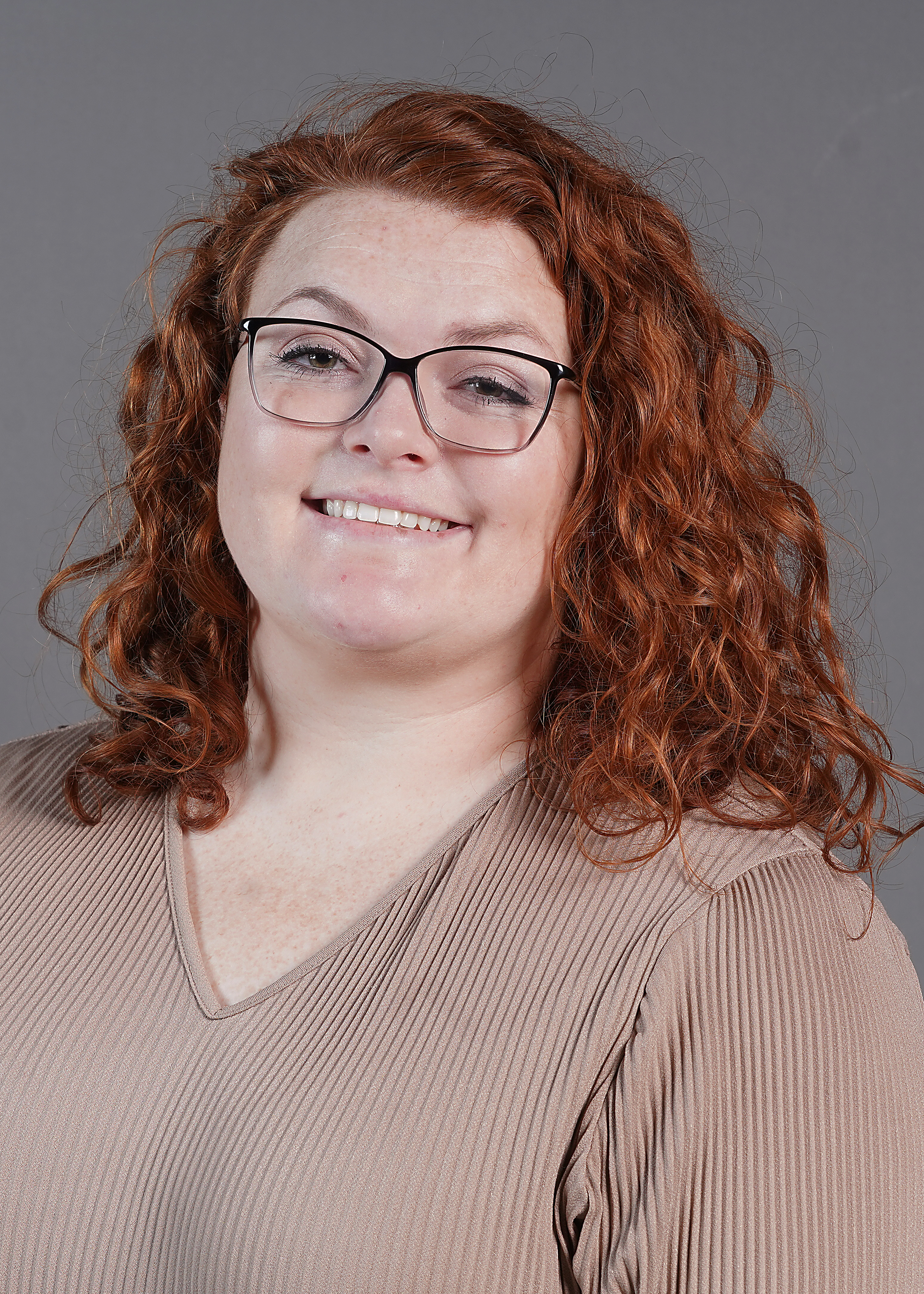
Hannah Lasher, 4-H Educator
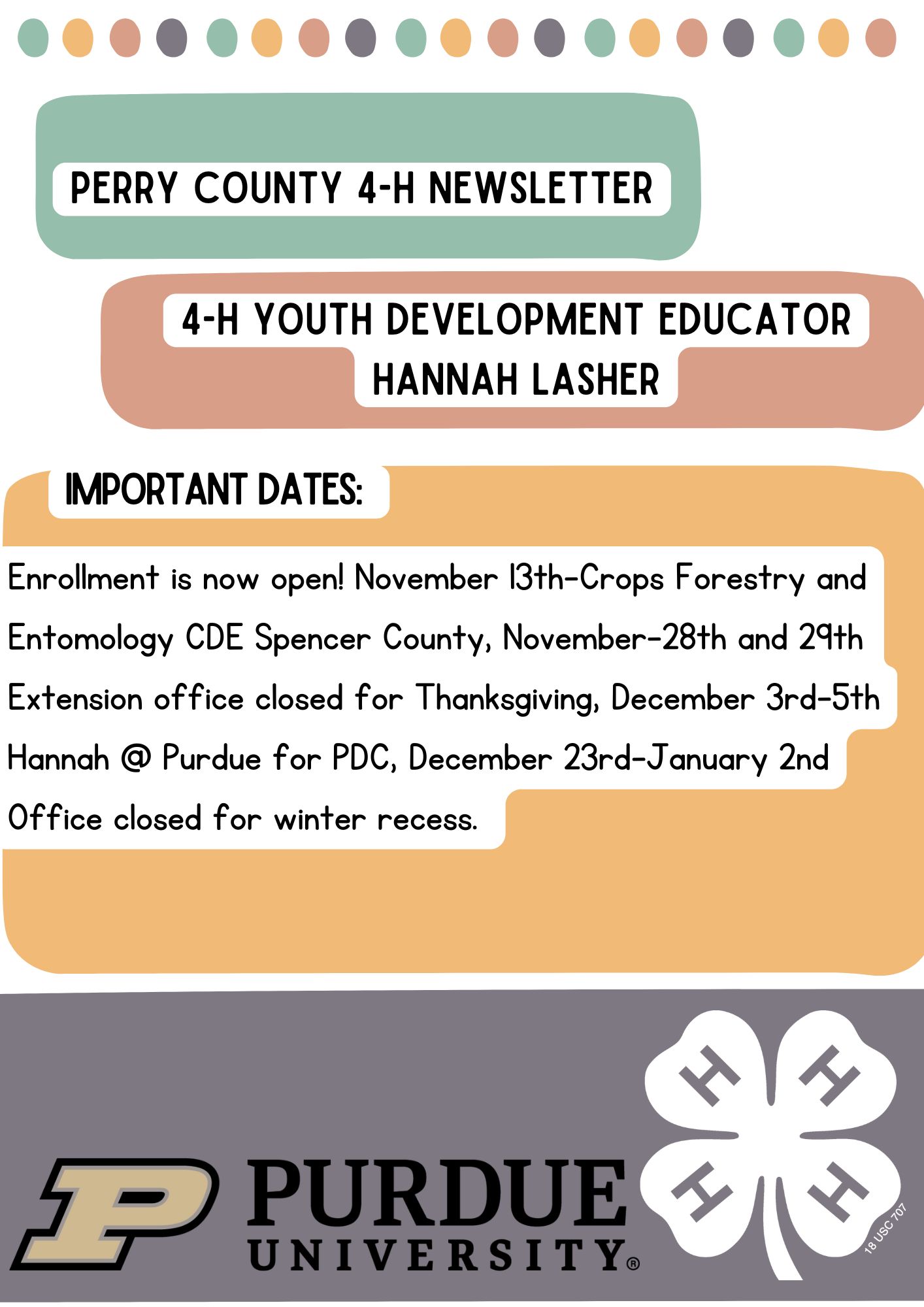
4-H Beyond Ready: Empowering Youth for Tomorrow
Welcome to our latest newsletter!
We are thrilled to share how our programs have been making a difference in the lives of youth, and we’re excited about what’s coming next. From hands-on experiences to community involvement, our mission is to equip young people with the skills they need to succeed in all areas of life.
Over the past year, we’ve seen incredible growth in our participants, thanks to programs designed to develop leadership, resilience, and practical skills. And as we look to the future, we have even more exciting opportunities for youth and their families.
In this edition, we’ll reflect on some of our most successful initiatives, highlight the life-changing power of 4-H, and give you a sneak peek at what’s in store for the upcoming year. Whether you’re a returning family or just getting started, there’s something for everyone!
Reflecting on Our Journey: Highlights from Recent Programs
This past year has been full of incredible opportunities for youth to grow, lead, and explore through our wide range of programs. From leadership development to unique trips, our youth have gained experiences that will shape their futures. Here are some of the highlights:
Junior Leaders: Preparing the Next Generation of Leaders Our Junior Leaders program brought together motivated teens eager to develop leadership skills and make an impact in their communities. Throughout the year, participants organized events, led club activities, and took on mentorship roles with younger members. This hands-on leadership experience empowered them to step up as confident, responsible role models both within and beyond 4-H.
4-H Camp: Building Friendships and Life Skills in the Great Outdoors This year’s 4-H Camp was an 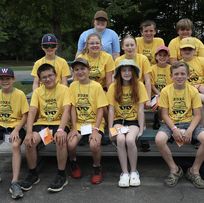 unforgettable experience for youth of all ages. Held in a beautiful outdoor setting, the camp provided a chance for participants to connect with nature, make new friends, and learn valuable life skills. Activities like team-building games, outdoor survival workshops, and campfire storytelling created lasting memories while teaching cooperation, resilience, and leadership.
unforgettable experience for youth of all ages. Held in a beautiful outdoor setting, the camp provided a chance for participants to connect with nature, make new friends, and learn valuable life skills. Activities like team-building games, outdoor survival workshops, and campfire storytelling created lasting memories while teaching cooperation, resilience, and leadership.
4-H Academy: Exploring Careers and Building Future Pathways The 4-H Academy gave teens a glimpse into future career paths through specialized workshops in areas like science, agriculture, and leadership. Participants had the opportunity to dive deep into fields of interest, attend career talks with professionals, and engage in hands-on activities that helped them envision their futures. The experience inspired many to start planning their academic and career journeys.
4-H Round-Up: Connecting with Peers Across the State 4-H Round-Up brought together youth from across the state to celebrate achievements, exchange ideas, and participate in fun activities. With a mix of competitions, workshops, and social events, Round-Up allowed youth to build networks and friendships with peers who share their interests and passions. It was a great opportunity for teens to showcase their talents and gain recognition for their hard work.
These programs and trips represent the many ways 4-H provides youth with opportunities to grow as individuals, leaders, and engaged citizens. As we look back on these accomplishments, we are excited to continue offering transformative experiences in the coming year.
4-H: Building Marketable Skills for the Future: 4-H is more than just a club—it's a platform that empowers youth to explore their passions, develop critical life skills, and prepare for the future. Whether it's through hands-on projects, leadership roles, or community involvement, 4-H participants learn valuable skills that help them thrive in both personal and professional life. Here's how 4-H helps youth get beyond ready for life’s challenges and opportunities:
Leadership & Communication from running club meetings to presenting projects at local fairs, 4-H teaches youth the art of leadership and effective communication. Participants learn how to speak confidently in front of groups, collaborate with peers, and take responsibility for leading activities. These leadership skills not only boost self-confidence but also prepare youth for future career opportunities where strong communication and teamwork are essential.
Practical, Hands-On Skills 4-H members engage in a wide variety of projects that help them develop real-world skills. From animal care and gardening to robotics and entrepreneurship, 4-H provides opportunities to explore areas of interest and gain marketable skills. These experiences translate directly into future career paths and help youth build a foundation for success.
Career Exploration Programs like 4-H Academy and 4-H Round-Up allow teens to dive deep into potential career fields. Whether they’re interested in agriculture, science, or leadership, these programs give youth a taste of what it’s like to work in different industries. With access to professionals, hands-on projects, and career workshops, participants leave with a clearer vision of their future paths.
Community Engagement: 4-H instills the value of civic engagement by encouraging youth to participate in service projects and local initiatives. From organizing food drives to participating in 4-H Day at the State House, members learn the importance of giving back and being active citizens. These experiences not only make a difference in their communities but also teach valuable lessons in leadership and responsibility.
Re-enrollment Starting Now!
4-H re-enrollment is here! If you or your child are looking to continue developing leadership, life skills, and a sense of community, now is the time to secure your spot for the upcoming year. Whether you're a returning member or new to 4-H, there’s always something exciting to explore. Visit 4Honline or contact the office at 812-547-7084 to learn more about how to re-enroll and take the next step in your 4-H journey!
We have an exciting year ahead filled with opportunities for youth to engage, explore, and develop new skills. Have an idea for future programming? Please reach out to the office and we can get started on it! Want to get involved with some of our other great programs? Anything from Outdoor Adventures to leadership-building events, there’s something for everyone. Here’s a look at some of the upcoming programs and events you won’t want to miss:
Outdoor Adventures Spark Club Get ready for an adventure! Our Outdoor Adventures Spark Club is the perfect way for youth to explore the great outdoors while learning important survival and teamwork skills. Participants will take part in activities like hiking, camping, and nature conservation, all while building confidence and fostering a love for the outdoors. 2025 dates and activities will be coming out closer to the New Year!
4-H Round-Up June 23-25, 2025 join us for 4-H Round-Up, where youth from across the state come 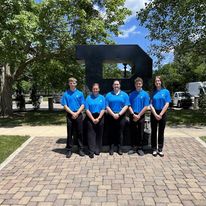 together to celebrate their achievements, participate in exciting competitions, and learn from one another. This event provides a unique opportunity for participants to showcase their skills and connect with peers who share similar passions. Band and Chorus trips coincide with Round-Up. Band-June 21-23 and Chorus 21-24.
together to celebrate their achievements, participate in exciting competitions, and learn from one another. This event provides a unique opportunity for participants to showcase their skills and connect with peers who share similar passions. Band and Chorus trips coincide with Round-Up. Band-June 21-23 and Chorus 21-24.
4-H Camp Summer 2025 May 30th-June 1st youth will have the chance to attend 4-H Camp, a week filled with fun, friends, and outdoor activities. Whether it’s learning how to build a shelter, honing leadership skills, or roasting marshmallows by the campfire, 4-H Camp provides unforgettable experiences that foster personal growth and lifelong friendships.
4-H Academy June 11-13 for those looking to explore potential career paths, 4-H Academy offers in-depth, hands-on learning in fields like science, agriculture, and leadership. Teens will have the opportunity to engage with professionals, work on real-world projects, and gain valuable insights into their future careers.
4-H Day at the State House February 11, 2025 Experience government in action during 4-H Day at the State House! Youth will get an inside look at how state government works, meet with legislators, and learn about civic engagement. This day inspires participants to become active citizens and think about the ways they can contribute to their communities.
Perry County Fair: July 11-15, 2025 Mark your calendars for the Perry County Fair, coming up July 11-15, 2025! This beloved local event is a highlight for many 4-H members, where youth can showcase their hard work through project exhibits, livestock shows, and competitions. The fair is a celebration of our community’s youth and their incredible achievements. Project check-in will be July 7th and FairEntry deadline will be June 20th next year. Indiana State Fair: August 1-17, 2025 Join us at the Indiana State Fair from August 1-17, 2025! This statewide event is a fantastic opportunity for 4-H members to display their projects, participate in competitions, and enjoy the excitement of the fair. From exhibits to performances, the Indiana State Fair celebrates the talents and accomplishments of 4-H youth across the state.
Perry County Ag News
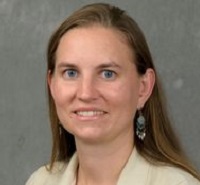
Sara Dzimianski, ANR Educator
Educator's Corner
Autumn is in full swing now, and while dry autumn conditions are normal for this region, the dryness we have seen this year is noteable. Fortunately most of our crops were made before the weather turned dry so overall Perry County had a good year for crops.
From a livestock standpoint we were fortunate to have two good rains while most of the state was dry, but now we are quite dry as well. Use caution with nitrate accumulating plants in livestock feeds since dry conditions can increase the concentration of nitrates. Ensure that all livestock have sufficient body condition for winter and supplement if necessary.
Vegetable gardens should have all plant material removed as plants die to prevent disease transmission to next year. Mark where plants were this year and plant the same species in a different location in the garden next year.
Autumn is a good time to identify invasive species in woodlands. Invasive species such as autumn olive and bush honeysuckle tend to stay green longer and retain their leaves longer than native species. Mark invasive shrubs for treatment in early spring before native species leaf out.
Happy Holidays!
Sara
Dec. 19 PARP to Focus on Crop Disease and Input Costs
Tar spot has arrived in Perry County. This is a fungal disease of corn that has caused significant crop losses in the northern part of Indiana. How should farmers manage this disease while keeping input costs low enough to maintain crop profitability?
Purdue Extension Crop Pathology Specialist Darcy Telenko will speak on this topic at the Perry County Winter PARP program to be held December 19 at 6:00 PM at the Perry County 4-H Fairgrounds located at 99 Roy Fenn Drive, Tell City.
This program is sponsored by Indiana Corn Marketing Council and Indiana Soybean Alliance so PARP fees will be waived.
For more information call the Extension Office at 812-547-7084 or email Sara at sdzimian@purdue.edu
Other Upcoming PARP Programs:
Nov 12 - Knox County PARP - Bicknell, IN Ph.(812)882-3509
Nov 12 - Pike County PARP - Petersburg, IN Ph.(812)354-6838
Nov 26 - Spencer County PARP - Chrisney (9 AM), Ph. (812) 812-362-8066
Nov 26 - Warrick County PARP - Boonville (4 PM), Ph. (812) 812 897 6100
Dec 12 - Dubois County PARP - Huntingburg, IN Ph.(812)684-9700
Dec 13 - Knox County PARP - Vincennes, IN Ph.(812)882-3509
Dec 19 - Gibson County Nutrien PARP - Princeton, IN Ph.(812)385-3491
Black Soybeans In Indiana. What Is Causing It And The Potential For Reduced Soybean Seed Quality
Source: Pest & Crop News, OCTOBER 11, 2024 - INCLUDED IN ISSUE: 2024.29
BY: DARCY TELENKO, SHAUN CASTEEL, JOHN BONKOWSKI AND TOM CRESWELL
There have been many reports of black areas in soybean fields in Indiana this season. These areas have appeared after weather from hurricane Helene passed through the region. In the field that I have observed recently, a few things were contributing to this issue– first areas with black soybeans showed up in previous pockets of poor growth due to drought conditions (dry hill tops) and/or other disease issues caused plants to shut down earlier than the rest of the field. In Casteel trials that were side by side, an earlier maturing variety was more symptomatic with black appearance with hanging, dead leaves (drought conditions plus another causal agent) compared to a fuller variety that showed no black appearance. It is possible there is a planting date/maturity effect. Soybeans that were reaching maturity earlier and beginning to dry down (or shut down) when the hurricane weather went through are the areas that are most impacted. When affected soybeans are harvested the dust cloud is black. In general, what we are seeing in samples coming into the clinic is saprophytic fungi – secondary colonizers that are responsible for breaking down and recycling the dead plant material.
A chill is in the air – online tools for monitoring and climatology
Source: Purdue Landscape Report, October 18, 2024 - Included in Issue: 24-14
By: Beth Hall
While our daytime highs across the state were in the upper 70s, our nighttime lows have been in the 30s (even into the upper 20s) in some places. This could get us thinking about the timing of the first frost and freeze events of the season, when the 7-day average 4-inch soil temperature falls before 50°F, and the viability of our home’s furnace. The Midwestern Regional Climate Center (MRCC) can help provide historical climatologies of the first two of those three. It keeps a positive thought for the third item. Keep reading.
Health & Human Sciences
Bringing University information to the local level to strengthen families, spend smart, eat right, and live well.

Contact Megan Jasperson, Health and Human Sciences Educator
mjaspers@purdue.edu
Perry County Office
65 Park Ave
Tell City, IN 47586
812-547-7084
Spencer County Office
1101 E. County Rd 800 N
Chrisney, IN 47611
Food As Medicine Program a Success and Coming to Perry Co!
The first Spencer County Food As Medicine program recently concluded and was a huge success. In partnership with the Spencer County Health Department, Gary’s Place Community Garden, and Cope’s Produce Company, Purdue Extension was able to provide this eight week program free of charge to all participants utilizing Health First Indiana funding. We have plans to replicate this in Perry County in 2025.
Each week participants came and learned about combating chronic disease through healthy eating, exercise, and good health habits. Information was shared on how to make lifestyle changes that aid in the prevention of heart disease, obesity, diabetes, and other chronic health conditions that are prevalent in both Spencer and Perry Counties as well as across our state.
Participants not only left armed with information, but each week they were provided with a box of fresh, locally grown produce that was provided by either Gary’s Place Community Garden or Cope’s Produce Company. Items varied from week to week but included potatoes, tomatoes, corn, watermelon, peaches, apples, peppers, cucumbers, yellow squash, and others.
Every class featured a recipe demonstration that utilized in-season ingredients that participants could easily replicate at home. A few examples include Turkey Chili Joe, Fresh Veggie Skillet, and Apple Slaw Salsa.
One participant shared, “I loved everything about this class! the information, recipes, food boxes and taste testing!” We loved sharing this with our community and are excited to bring this to Perry County in 2025.
County Residents Moving More Thanks to Get WalkIN’ Program
Walking is a popular form of physical activity—and good for your health! Only half of all American adults get the recommended amount of physical activity. Lack of physical activity is directly related to the occurrence of adult obesity and overweight. Regular physical activity can lower risk of heart disease, high blood pressure, type 2 diabetes, osteoporosis, depression, and falls in older adults. Walking is an excellent way for most people to increase their physical activity. It is an easy way to start and maintain a physically active lifestyle. Walking is accessible to almost anyone, doesn’t require specific skills or fancy workout clothes and equipment.
A group of Perry County residents recognized these benefits and joined the Get WalkIN’ program to kickstart their walking journey. This is an e-mail based walking program that was offered through Purdue Extension in conjunction with the Perry County Health Department utilizing Health First Indiana funds. Participants signed up, walked on their own and received e-mailed support and information. Get WalkIN‘ aims to promote increased physical activity by adults through walking, and this program helped Hoosiers get on their feet!
Get WalkIN‘ spanned 12 weeks, with pre-developed e-mail messages being sent to participants twice weekly for the first four weeks and then weekly for the next eight weeks. These messages targeted principles of self-efficacy, social support, and goal setting. If you are interested in resources to help you get started, reach out to Megan at mjaspers@purdue.edu!
Matter of Balance Increased Confidence and Knowledge for All Participants
A Matter of Balance is a fall prevention program that encourages cognitive restructuring. It is designed to reduce the fear of falling and increase activity levels among older adults. This is an evidence-based program that is implemented across the nation, and thanks to Health First Indiana Funding we were able to offer a full class in Tell City. Purdue Extension partnered with the Council on Aging and the Health Department to provide this at the William Tell Center in September and October. Participants were lead through discussions related to fall risks, physical environment, and other factors that increase the probability of falling. Brandi Labhart from ARI shared information from a lens of a professional that works with fall patients on a regular basis.
We will be offering this class again in 2025. If you are interested in getting your name on the list for information on our future class, please call our office at 812-547-7084 or email Megan at mjaspers@purdue.edu.
Bye-bye germs: How to sanitize (the right way) in the kitchen and beyond
“Sanitizing” is different from cleaning. That’s one of the many things people get wrong about removing germs that Purdue experts want consumers to understand. Amanda Deering, associate professor of produce food safety, and Tari Gary, extension administrator for food science, teach growers how to remove germs from produce, but they also offer tips for sanitizing at home.
What is a sanitizer? “A sanitizer reduces the number of microorganisms on a surface,” said Gary. “It’s different than a detergent or a sterilizer. Detergents just remove visible contaminants, and sterilizers remove all microorganisms.” Sanitizing a surface has three steps: Clean the surface Read the sanitizer’s label Sanitize according to the label’s instructions Each of these steps plays an important role in killing germs and keeping people safe. “A common misconception is that you can apply a sanitizer to a dirty surface,” said Gary. “To get that full effectiveness promised on the label, clean the surface first, making it as visibly clean as it’s going to get. Then, apply the sanitizer. If you don't do that, the sanitizer is going to be used up before it gets down to the surface.”
After cleaning, and before sanitizing, people should always review the product’s label first. Otherwise, they could endanger themselves by not taking proper precautions. “Stick to the label,” Deering cautions. “Some people say, ‘A little is good, but a lot is better,’ but that’s not true with sanitizers. If you don’t follow the label, there’s a real risk of using the sanitizer at too high a concentration or using a sanitizer for an unintended purpose.”
For example, Deering recalls one time a woman contacted her after a sanitizer made her skin turn white. “In the past, she had bought a diluted version of the sanitizer, but she accidentally bought the same product with a higher, almost dangerous concentration,” Deering said. Thankfully, the woman was okay, and the effect was temporary. The situation might have been avoided, however, with careful label reading. Consumers should pay special attention to labels if they plan to sanitize a food-contact surface. Common sanitizers like sanitizing wipes or aerosol disinfectant sprays work well for many household needs, but they may not work for food-contact surfaces.
“The danger is that you could ingest harmful ingredients from the sanitizer,” Gary explained. Even if a product is approved for food-contact surfaces, consumers should pay attention to what microorganisms the product is designed to kill. For example, a product label showing “kills Salmonella” would make sense to use after cooking raw chicken but not if the consumer was concerned about Listeria. “Just look at the label,” Deering said. “Before you use any sanitizer, make sure it’s labeled, especially if you want to wash or sanitize a food contact surface. You have to be careful what you're using.”
"MAKING THE HEALTHY CHOICE, THE EASY CHOICE.”
ERIN MEYER, RDN - COMMUNITY WELLNESS COORDINATOR
Do I Qualify For SNAP?
To qualify for the Supplemental Nutrition Assistance Program, applicants must meet certain non-financial and financial requirements. Non-financial requirements include state residency, citizenship/alien status, work registration and cooperation with the IMPACT (job training) program. Financial criteria include income and asset limits. The asset/resource limits are $5,000 for most households.
Assets include bank accounts, cash, real estate, personal property, vehicles, etc. The household's home and surrounding lot, household goods and personal belongings and life insurance policies are not counted as assets in the SNAP program. All households (except those with elderly or disabled members) must pass a gross income test (130% of poverty) to qualify for SNAP benefits. The gross income is per household size and based on the gross monthly income received by all household members. For more information, please visit: https://www.in.gov/fssa/dfr/snap-food-assistance/do-i-qualify-for-snap/
November is Diabetes Awareness Month
Visit this site for more information on Diabetes: https://diabetes.org/about-diabetes/diabetes-myths
10 Holiday Home Food Safety Tips
Enjoying food with family and friends is one of the highlights of the holiday season! While it's great that everyone wants to help, too many cooks in the kitchen can result in an increased risk of food poisoning, which can cause severe and even life-threatening illness. Easy-to-follow, safe food handling practices help protect everyone in the family from getting sick.
Here are some food safety tips to help avoid common kitchen blunders when preparing meals, buffets and even homemade food gifts this holiday season.
Share the Gift of Home Food Safety This Season
Follow these simple steps to properly handle food and reduce the risk of food poisoning:
- Defrost carefully. Never allow foods to thaw at room temperature, on the counter or in warm water. Defrost food only in the refrigerator, microwave or in a cool water bath (inside a leak-proof plastic bag) with water that is changed every 30 minutes. When defrosting food in the refrigerator, remember to cover raw meat and place it on the bottom shelf so juices won't drip onto other foods. When thawing food in the microwave, cook it immediately afterward.
- Wash hands before, during and after food preparation. Proper hand-washing may eliminate a large percentage of food poisoning cases. Remember to wash hands when switching tasks, such as handling raw meat and then cutting vegetables. Wash hands with soap in clean, running water for at least 20 seconds.
- Keep kitchen surfaces clean. Use hot, soapy water to wash countertops and surfaces, cutting boards, refrigerator door handles and utensils. After tidying up, keep it clean by avoiding cross-contamination.
- Use two cutting boards. Dedicate one for raw meat, poultry and fish and the other for ready-to-eat foods, such as fruits and vegetables. Make it easy to remember by using color-coded cutting boards, one for raw meats and one for ready-to-eat foods.
- Employ different utensils for different tasks. Use separate spoons and forks to taste, stir and serve food.
- Resist temptation. When baking, avoid eating foods containing raw eggs or uncooked flour, such as cookie dough or cake batter. These ingredients may contain bacteria that can lead to food poisoning if not cooked first.
- Buy and use a food thermometer. It is the only reliable way to determine the doneness of your food and ensure that food is cooked to proper internal temperatures. (Do not rely on "clear juices" to tell that the turkey is done.)
- Refrigerate food within two hours of serving. This helps to prevent the growth of harmful bacteria that can lead to food poisoning and is especially important when serving buffets. Use a refrigerator thermometer and make sure it's set at below 40°F.
- Know how to handle mold. Discovering your ingredients have gone bad can be disappointing, but don’t put your family or guests at risk by serving food that may make them ill. A few foods, such as firm fruits and vegetables and hard cheese, can still be used if you remove about one inch around the moldy spot. Soft fruits, vegetables, cheeses, casseroles and any foods with a high moisture content, such as bread, jam or yogurt, should be discarded if it begins to mold.
- Practice kitchen safety. Ensure your kitchen is ready with the tools and resources you need before the big event.
For more information, please visit: https://www.eatright.org/food/cultural-cuisines-and-traditions/holidays-and-celebrations/10-holiday-home-food-safety-tips
Are you in need of Emergency Food Resources?
Widows Barrel Food Pantry
821 10th Street
Tell City, IN 47586
(812) 547-0834
Open Tuesday 9:00 am - 2:00 pm,
Wednesday 12:00 - 5:00 pm
Seventh Day Adventist Food Pantry
434 13th Street
Tell City, IN 47586
(812) 547-5038
Open Tuesday 9:00 am - 12:00 pm
Council of Agencies
817 Blum Street
Tell City, IN 47586
(812) 547-7780
Open Mon, Wed, Fri 9:00 am - 11:30 am (Food)
Tues 9:00 - 11:00 am (Clothing)
Cannelton Food Pantry
200 North 5th Street
Cannelton, IN 47520
(812) 719-5544
Open Tuesday 9:00 am - 12:00 pm, Thursday 9:00 am - 12:00 pm
Martin’s Cloak Food Pantry
27246 Perry Street
Siberia, IN 47515
(812) 357-7575
Open the 2nd & 4th Saturdays
8:30 am - 11:00 am
Deer Creek Baptist Food Pantry
6733 Alamo Rd
Tell City, IN 47586
(812) 719-3909
Open the last Saturday of the Month
10:00 am - 1:00 pm
Free Community Meals - Families Welcome
Shepherd’s Table
Community Christian Church -
Fellowship Hall
821 10th Street
Tell City, IN 47586
(812) 547-7486
Tuesday - 5:00-6:00 pm
Table of Blessings
EUCC Fellowship Hall
Corner of Jefferson and 10th Streets
Tell City, IN 47586
Free, Hot, Nutritious Meals
Thursday - 5:00-6:00 pm
Nutrition Education Program
Danica Williams
Nutrition Education Program Advisor
Purdue Extension-Perry County Office
65 Park Avenue Tell City, IN 47586
Cell: 270-993-8549 Office: 812-547-7084
Email: will1179@purdue.edu
